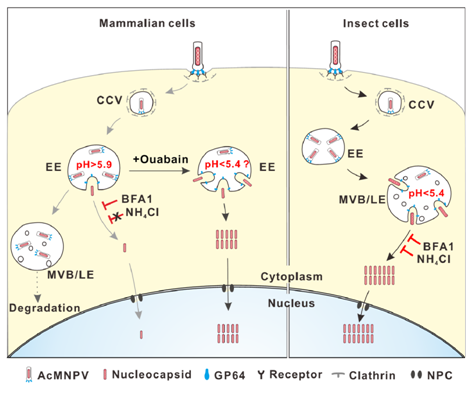Scientists uncover the roadblocks to mammalian cell entry of baculovirus
Date:06-06-2019 | 【Print】 【close】
Baculoviruses are a diverse family of enveloped large DNA viruses that cause systemic infection in their host insects. Although they infect insects in nature, baculoviruses can transduce and deliver foreign genes of large sizes into a wide range of mammalian cells (including human cells) without replicating and genomic integration.
Thus, baculoviruses, especially the prototypical baculovirus Autographa californica multiple nucleopolyhedrovirus (AcMNPV), have been considered an ideal vector for gene delivery and therapy in the past decades. However, AcMNPV entry into many mammalian cells exhibits low efficiency, which greatly limits the application of AcMNPV as a practical gene delivery and gene therapy vector.
In a recent study, the research groups led by Prof. WANG Hualin and Prof. HU Zhihong in Wuhan Institute of Virology of the Chinese Academy of Sciences uncovers the roadblocks encountered to mammalian cell entry of baculoviruses and presents mechanisms to overcome the roadblock.
In this study, by comparatively analyzing the mechanism of baculovirus entry into mammalian and insect cells, virus fusion during the early stage of endocytosis was revealed as the major obstacle for efficient baculovirus transduction into mammalian cells. A higher fusogenicity of the major viral fusion protein GP64 was found to be required for virus entry into mammalian cells than into insect cells. Interestingly, by decreasing pH of early endosomes with a specific agent, virus transduction of a wide range of mammalian cells was greatly enhanced.
Overall, their findings uncovered why baculoviruses enter mammalian cells with low efficiency and provide a novel strategy of increasing GP64 fusogenicity by decreasing endosomal pH for further improvement of baculovirus-based gene delivery and therapy.
Thid study was published in Journal of Virology entitled “The major hurdle for effective baculovirus transduction into mammalian cells is passing early endosomes”.
This work was supported by the grants from the National Natural Science Foundation of China, Strategic Priority Research Program of the Chinese Academy of Sciences, a grant to JMV from the State Key Laboratory of Virology and the Wuhan Institute of Virology

Schematic diagram illustrating the proposed mechanism of AcMNPV entry in mammalian and insect cells. Image by WANG Manli
Contact:
WANG Manli
E-mail: wangml@wh.iov.cn
Wuhan Institute of Virology, Chinese Academy of Sciences, Wuhan 430071, China. (http://english.whiov.cas.cn/)